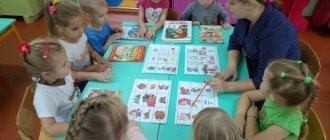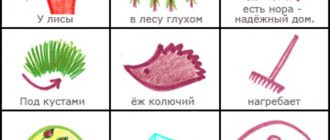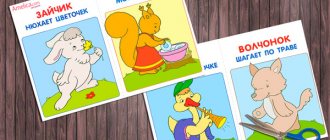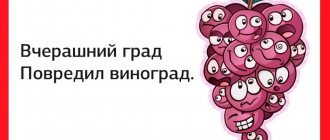Mnemotables “Favorite Tales”
Good day! I really love doing theatrical activities with my students. In addition to performing at holidays and in theater productions, it is very important that group rooms have the necessary conditions for the development of children's creative potential. I present to you cards - mnemonic tables.
A mnemonic table is one of the most popular and effective techniques (mnemonics) that can be used to facilitate the process of memorizing and reproducing information by preschoolers, developing thinking and speech. In my mnemonic tables, there are sequential images in which the content of fairy tales is encrypted. When an adult listens to a fairy tale, the child remembers it not only by ear, but also by visual perception. He can retell a familiar fairy tale.
On the back of the cards I placed the fairy tale itself in the form of text. It is intended for a teacher, if suddenly he is not familiar with this fairy tale or has forgotten some details.
I took pictures of fairy tales from the Internet, but mainly from this site: https://www.detiam.com/
Next, I want to offer my colleagues the opportunity to use my work.
Wolf and 7 kids. Table DOCX / 2.8 MB Wolf and 7 kids. Text DOCX / 14.18 KB Zayushkina's hut. Text DOCX / 14.93 Kb Zayushkina's hut. Table DOCX / 2.8 MB Kolobok. Table DOCX / 4.27 MB Kolobok. Text DOCX / 19.28 Kb Who said meow. Suteev. Table DOCX / 22.51 KB Who said meow. Suteev. Text DOCX / 753.89 Kb Chicken Ryaba. DOCX table / 3.65 MB Chicken Ryaba. Text DOCX / 12.63 Kb Chanterelle with a rolling pin. Table DOCX / 796.68 KB Chanterelle with a rolling pin. Text DOCX / 17.42 KB Little fox-sister. Table DOCX / 542.95 KB Little fox-sister. Text DOCX / 16.21 KB Masha and the Bear. Table DOCX / 687.65 Kb Masha and the Bear. Text DOCX / 17.88 KB Comb cockerel. Table DOCX / 774.23 Kb Comb cockerel. Text DOCX / 18.04 Kb Under the mushroom. Suteev. Text DOCX / 17.19 Kb Under the mushroom. DOCX table / 1.01 MB Turnip. DOCX table / 5.51 MB Turnip. Text DOCX / 14.51 KB Teremok. Table DOCX / 605.37 KB Teremok. Text DOCX / 16.55 Kb Three kittens. Suteev. Text DOCX / 18.4 Kb Three kittens. Table DOCX / 539.71 Kb Three bears. Table DOCX / 706.85 Kb Three bears. Text DOCX / 16.98 Kb The Three Little Pigs. Table DOCX / 1.1 MB Three Little Pigs. Text DOCX / 24.51 Kb Chicken and duckling. Suteev. Text DOCX / 17 Kb Chicken and duckling. DOCX table / 577.2 KB
Mnemonic tables and their application, as well as schemes for composing stories
Mnemonic tables for compiling descriptive stories.
Learning how to write descriptive stories is important! for the development of the child, because the ability to accurately, concisely and figuratively describe a subject is a condition for improving speech and thinking and facilitates the process of information exchange. One of the factors that makes writing descriptive stories easier is diagrams. The structure of the mnemonic table and working with it.
Mnemonics – translated from Greek – “the art of memorization.” This is a system of methods and techniques that ensure successful memorization, preservation and reproduction of information, knowledge about the characteristics of natural objects, the world around us, effective memorization of the structure of a story, and, of course, the development of speech. Using mnemonics, you can solve the following problems: – development of coherent and dialogic speech in children; – development in children of the ability, with the help of graphic analogy, as well as with the help of substitutes, to understand and tell familiar fairy tales and poems using a mnemonic table; – teaching children correct sound pronunciation; – development in children of mental activity, intelligence, observation, the ability to compare, and identify essential features; – development of mental processes in children: thinking, attention, imagination, memory...; Most children cannot coordinate words in a sentence; their sound pronunciation and syllabic structure of words are impaired. As a rule, such children have poor memory, absent-minded attention, and many suffer from imperfect logical thinking. If you have difficulties with your child in describing objects or constructing a plot, then use hint diagrams - mnemonic tables that will allow you to more effectively perceive and process visual information, save and reproduce it.
An example of the story "Autumn".
Autumn has come. The sun shines little and does not warm. It is hidden behind gray clouds. It rains often. We go to kindergarten under an umbrella. Strong wind blows. And the leaves fly off the trees. The leaves cover everything around with a beautiful, colorful carpet.
An example of the story "Spring".
Spring has come. The sun gets hotter and it becomes warmer. The snow is melting outside and streams are flowing. Girls and boys launch boats on the water. The first buds are blooming on the trees and the first flowers are appearing. Birds fly from hot countries. An example of the story "Summer".
N
Summer has come. The sun shines brightly and warms. Boys and girls swim in the river. They play ball and badminton. Towers and castles are built from sand. In summer, delicious fruits, berries and healthy vegetables ripen. An example of the story “Winter”.
Winter came. The sky is covered with gray dark clouds. It often snows cold. Girls and boys go for a walk outside. They make snowballs and a snow woman out of snow. In winter, the children go sledding and ice skating.
I would like to emphasize that mnemonic tables are not limited to all work on the development of coherent speech in children. This is primarily as an initial, “starting”
, the most significant and effective
work , since the use of mnemonic tables allows children to more easily perceive and process visual information, store and reproduce it.
In parallel with this work , speech games are necessary, the use of board-printed games is mandatory, which help children learn to classify objects, develop speech, visual perception, imaginative and logical thinking, attention, observation, interest in the world around them, and self-test skills.
Using a mnemonic table in kindergarten
Linaria Shaikhutdinova
Using a mnemonic table in kindergarten
The formation and active development of the level of coherent speech for preschoolers requires not only the increased attention of both parents, but also specialized classes that can be conducted in a playful or theatrical form, which is especially attractive to children. In the process of working with children, speech therapists and teachers use mnemonics stands out , aimed at actively developing the level of coherent speech and memory in preschool children.
What is mnemonics
Mnemonics for increasing the level of speech development is a set of techniques aimed at improving perception with memorization of various information using sound samples and visual illustrations.
Provided that classes are carried out systematically, mnemonics for speech development allow you to:
• improve memorization of heard texts in the form of stories, fairy tales, etc.;
• transform visually acquired data into abstract ones (and vice versa)
;
• create logical chains of events;
• Expand words knowledge;
• stimulate the development of imagination and thinking;
• develop children's ability to compose complex sentences of a descriptive type, which include many words.
Mnemonics , as one of the most effective methods of memorization, is actively used not only by speech therapists, but also by teachers in kindergartens and other preschool institutions.
There are no age restrictions for classes, but many specialized experts recognize the age of 4-5 years as the most optimal, when children already have a fairly rich and varied stock of words and phrases that they can actively use.
The main tool that is used in mnemonics for developing the level of coherent speech in preschool children are mnemonic tables - specific diagrams in which certain information data is embedded.
Mnemonic diagrams for the little ones should be painted in bright shades so that the image that a frog is green, a chicken is yellow, etc. is imprinted in their minds.
For older children, it is preferable to use single-color schemes that do not distract attention, distracting them with additional, and often unnecessary, details.
Areas of use
Mnemonic tables for the formation and development of coherent speech (developmental and educational)
– these are images of text information, which is previously divided into groups of words in sequential order. There is one illustration for each group of words. Thanks to such a schematic sketch of information, the baby easily perceives it, remembering everything without much effort.
Using mnemonic tables for speech development, the following is carried out:
• Memorizing fairy tales or rhymes. Young children take part with great interest in educational games based on fairy tales they know. At home, you can invite your child to tell a story to his favorite toy, using a series of pictures. You can also jointly draw a mnemonic table , depicting the heroes of events with your own invented symbols, for example, a triangle is a person, a wavy line is a cloud in the sky. Thus, not only the formation of coherent speech occurs, but also the active development of imagination and fantasy with the manifestation of the hidden creative abilities of children.
• Learning general rules, such as how to brush your teeth correctly. The diagrams depict the sequence of all manipulations that are easily perceived and remembered.
• Compiling stories describing objects, events, pets, etc. Based on pictures that answer basic questions: who is it, what color, what sounds does it make, what does it like to eat, etc., children can create a consistent description.
• Work on retelling. After reading the text, the most difficult words are highlighted, the meaning of which must be explained to the child. After the explanations, a conversation should be held on the entire content of the text with a demonstration of drawings from the mnemonic table . A joint retelling using pictures will allow the child to quickly remember information and tell the story he heard himself.
• Solving riddles. With the help of mnemonic tables, children learn to identify an exact object, focusing on its characteristics. At the first stage, it is necessary to explain to the child everything that is depicted in each picture, and only after that offer to independently guess the encrypted object.
Speech therapy classes on the development of coherent speech using a variety of mnemonic diagrams involve memorizing and deciphering the plot illustrations given in the table. The type and thematic content of mnemonic tables can be different , execution can be printed (Doman cards)
or made by hand. Cards for speech development in the first lessons should be small with light storylines; it is recommended to place 3-4 of them in one row, in this position they are easier to perceive.
How to create mnemonic tables
Drawing up mnemonic tables involves performing the following manipulations:
1. breaking the text into parts (focusing on the most important points)
;
2. dividing a sheet of paper into squares (the number of squares depends on the highlighted parts of the story)
;
3. depiction of each moment in the picture (both nouns and adjectives can be described)
;
4. words that are difficult to sketch (verbs or questions can be depicted as a “?”
(the child must comment on them)
.
To facilitate the perception of fairy tales or riddles by young children, the works are broken down into individual situations, which are subsequently transferred to pictures for children.
When practicing in the form of a game with mnemonic tables, children are encouraged to :
1. review speech therapy cards;
2. remember what was described;
3. talk about what you saw, focusing on the pictures.
When use mnemonics and perform assigned tasks, they actively carry out the following processes:
• viewing diagrams and understanding what you see;
• transformation of visual data into figurative data, identification of what is seen with a concept;
• compiling a story based on drawings;
• memorizing fairy tales, stories, etc.
Older preschoolers can themselves take part in compiling mnemonic tables , focusing on the words of the teacher who broke down the story (fairy tale, riddle)
on the situation, explaining what needs to be drawn.
The simplest and most interesting option is to depict a mnemonic table on the theme of the seasons (summer, winter, etc.)
or based on fairy tales
(best of all, your favorite ones)
.
The development of children's coherent speech in older preschool age is also possible and necessary at home (at any time convenient for parents and the baby)
.The following can help with this:
• joint reading of books with fairy tales, equipped with bright illustrations, reciting the main points and highlighting key characters and events;
• regular use of fiction as an effective means for increasing the level of development of coherent speech;
• a large book with tasks and exercises aimed at the active development of a child’s coherent speech (can be purchased in the children’s developmental literature department of any bookstore);
• Doman cards;
• methodological recommendations for the development of coherent speech;
other methods at the discretion of parents and the advice of teachers and speech therapists.
Mnemonic tables for children with OHP
The concept of coherent speech and its significance for the development of a child with general speech underdevelopment (GSD)
has a direct relationship with the logic of thinking and the ability to realize the images seen or sounds heard, expressing this through consistent speech in which there are logical chains. The general level of development of coherent speech inherent in preschoolers with ODD depends on the ability to think through information and construct statements on a variety of topics.
Dialogical speech is displayed in the communication of several people, often accompanied by simple monosyllabic statements, asking specific questions and composing options for answers to the interlocutor’s questions, followed by reproduction of the selected answer. In this process, a special role is played by formulating and asking questions, constructing answers and reasoned defense of one’s opinion. Coherent monologue speech in preschoolers is characterized by expansion and concentration of thoughts on the main thing, without delving into details. In the process of reproducing one’s thoughts and choosing linguistic means, internal motives play a decisive role, since it is they that stimulate monologue speech.
The features of the stages of development of coherent monologue and dialogic speech vary, but both types are closely interrelated. This nuance must be taken into account when conducting classes aimed at stimulating the development of coherent speech in children with ODD.
The introduction of mnemonics into speech development classes for preschool children should be carried out using mnemonic squares , in which the simplest words are encrypted (boy, girl, sun)
.
Only after children understand the concept of “encryption”
can they move on to more difficult variants of schemes -
mnemonic tracks with mnemonic tables , which can be based on a whole story.
Mnemonic track “Two funny geese” .
Using this technique during classes with children with special needs allows:
• increase attention and interest in games with logic cards;
• facilitate the perception and processing of information data that
• are stored in memory and can be played back if necessary.
Effectiveness of application
The introduction and use of mnemonic tables in the process of developing coherent speech of preschoolers of different ages is of significant importance, since in addition to significantly expanding their vocabulary, children can:
• expand your knowledge about the environment;
• learning rhymes is fun and enjoyable, without really thinking about it;
• get used to retelling information heard on various topics, both in your own words and those that were heard.
The development of coherent speech in children of senior preschool age with the introduction of mnemonic can show the first results quite quickly if they are interested, and the process itself does not cause a feeling of resistance. Favorite fairy tales and poems, taken as a basis when compiling mnemonic squares or mnemonic tracks , will make it clear to the child that retelling what he heard in his own words or composing new stories is not at all difficult, but on the contrary, interesting.
Main features of mnemonic diagrams for institutions for preschool children
Mnemonic diagrams in kindergarten are primarily designed for its pupils, that is, children aged 3-7 years (it is worth noting that according to the “Accessible Environment” program, namely the clause on inclusive education, children with health limitations should be given the opportunity to attend kindergarten on an equal basis with everyone). Thus, standard mnemonic diagrams will be inappropriate in kindergarten. It is unlikely that three-year-old children have already learned Braille.
Thus, such equipment should help provide information in a different way. Of course, the clarity of the relief plays a dominant role, but there are other ways of transmitting information. Today, mnemonic diagrams with speech information are quite in demand. This type of equipment will look most appropriate in a preschool educational institution.
When making mnemonic diagrams that will be installed in a kindergarten, the manufacturer must take into account some more nuances. The main ones include the dimensions of the equipment for people with disabilities and the height of the rack for the mnemonic diagram.
Effectiveness of application
The introduction and use of mnemonic tables in the process of developing coherent speech in preschoolers of different ages is of significant importance, since in addition to significantly expanding their vocabulary, children can:
- increase knowledge about the environment;
- learning rhymes is fun and enjoyable, without really thinking about it;
- get used to retelling information heard on various topics, both in your own words and those that were heard.
The development of coherent speech in children of senior preschool age with the introduction of mnemonic techniques can show the first results quite quickly if they are interested, and the process itself does not cause a feeling of resistance. Favorite fairy tales and poems, taken as a basis when compiling mnemonic squares or mnemonic tracks, will make it clear to the child that retelling what he heard in his own words or composing new stories is not at all difficult, but on the contrary, interesting.
How to create a mnemonic table when working with text
The mnemonic table includes a wide range of words and phrases; everything can be encrypted in it, but children should work with it from simple to complex. Therefore, preschoolers first learn the concept of mnemonic squares (drawing diagrams).
The first stage is mnemonic square
In it, the adult encrypts the word and shows the child a diagram enclosed in a square window. For example, the word "thunderstorm" could represent the following pattern:
| A cloud with dotted slanted lines coming out of it (rain), crossed out by a broken line (lightning). |
You can depict any word in a mnemonic square, the main thing is that it is accessible to children. The subject matter is different, it can be objects, animals, their properties and actions. The goal is to teach the child to correlate an image-scheme with an object or action and see its relationship with the world around him.
Children love this exercise and are happy to encode different words, it is good if parents encourage this.
The second stage - mnemonic tracks
After mastering the mnemonic square, they move on to mnemonic tracks, i.e., several “windows” in which a phrase or sentence is depicted. The child, under the guidance of an adult, first moves from one square to the next and, with the help of drawn diagrams, recalls the text, and then does this independently.
For example, a sentence composed together with a child, “The cat pulled a ball out of the basket and is playing with it,” can be encrypted as follows:
| Schematic image of a moving cat. | Basket with colorful balls. | Tangled lines are threads from a ball, next to it is an image of a cat. |
Parents, teaching their child to encode words in home games, solve several problems at once:
- speech development;
- creative self-expression of the baby;
- independence in games.
The third stage - mnemonic table
And as the final stage of the mnemonic technique, the compilation of mnemonic tables with a schematic representation of the text. This could be any work or story that was invented by an adult, the main thing is that the content is accessible to the child. In the future, just as in working with squares and paths, children independently come up with and encrypt any texts.
This is what a mnemonic table might look like, which schematically depicts a story compiled by children.
“Cold winter has arrived. A lot of snow fell. The guys dressed warmly and went for a walk. They built a slide outside and went sledding. Then they made a snowman and played snowballs. It's fun to walk in winter! »
| Big letter "Z" - winter. | Image of snowflakes. | Winter landscape: a house, smoke coming from the chimney, snowdrifts nearby. |
| A schematic representation of children dressed warmly: hats, mittens, felt boots. | A slide, next to it there are sketchy figures of children with sleds. | Image of children's figures on skis. |
| Circles representing snowballs. | Snowman image. | Schematic representation of children's smiling faces. |
From such stories, you can compose entire cycles according to the seasons, and from the pictures-schemes drawn by children, you can make homemade albums-books, which preschoolers can look at and retell the works. This is an excellent way to develop not only children’s coherent speech, but also creative imagination, fine motor skills, and drawing skills.
Most of all, children like to encrypt fairy tales or funny rhymes. The main image in the mnemonic tables should be the characters and their actions, so that the retelling is easier for the preschooler. The properties of objects encrypted in the tables will be available to older children after special training.
Parents who are interested in helping their child master the richness of their native language can take an active part in compiling these types of tables.
For example, fairy tales about animals and objects, with a simple plot, a small number of characters and dynamics of development, can be easily encoded and become a game for preschoolers. This is what the fairy tale “Zayushkina’s Hut” might look like.
| An image of an ice hut, next to it is a schematic image of a fox. | Bast hut, next to it is a schematic image of a bunny. | The bunny's hut and the puddles from the fox's hut. |
| Image of a fox and a hare. Next to it is a picture of a bunny's house. | A bunny's face with drops of tears. | Schematic figures of a dog and a hare. |
| Image of figures of a wolf and a hare. | Schematic representation of the figures of a bear and a bunny. | Image of figurines of a cockerel and a bunny. |
| A sketchy face of a fox looking out of a window. | An image of a smiling bunny face. | Teapot, cups, treats for the cockerel and bunny. |
You can encrypt any fairy tale in this way. But for such activities with the child, it is better not for parents at first not to take fairy tales like “The Frog Princess” that are voluminous in content, abundance of characters and numerous actions, since the arbitrariness of mental processes in preschoolers is just being formed, and long-term work can extinguish interest child.
The greatest effect from the action of the mnemonic table is achieved when working on poems and retellings of texts, since their use in speech development solves many problems: it makes it easier for the child to perceive and assimilate the text, establish the sequence of presentation of the content, and reproduce it according to the plan-scheme. Among children's works, you can select poems for learning with children and coding them in mnemonic tables. These can be both works of classics, A. Barto, V. Berestov, S. Marshak, and texts of modern authors. It all depends on the creative orientation of adults and children, the level of development of their coherent speech.







